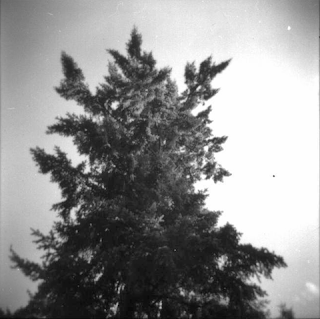 When I reached my last day in the darkroom for the quarter, I realized I wouldn't be able to print all of Susan's negatives. This was frustrating and a little depressing. The design of the project revolved around the physicality -- what Susan describes as kinesthesia -- of working with old-fashioned manual photo processes.
When I reached my last day in the darkroom for the quarter, I realized I wouldn't be able to print all of Susan's negatives. This was frustrating and a little depressing. The design of the project revolved around the physicality -- what Susan describes as kinesthesia -- of working with old-fashioned manual photo processes.One long-term goal for this project is to take the physical prints and augment them with a medium that will allow them to be touched. To be experienced by feeling them. No prints; no augmentation, I thought at first. But then I realized something about problem-solving that leads me to this post.
When I was younger, my peers and I were encouraged to pursue degrees in the sciences. My secret ambition was to be an artist, but I didn't give myself permission to study art. Instead, I studied zoology, which probably put me closer to a study of beauty than I would have imagined.

I learned to appreciate the broken regularity of nature, the harmonious cycles of life, the delicate interplay of animal societies. A frog egg spontaneously grows and divides, cells multiplying in mathematical progression and taking shape ordained by the distribution of yolk (heavier yolk leading to larger cells on the bottom and lighter yolk becoming smaller cells on the top.) The fibonacci whorls of a nautilus shell, the strength of a delicate spider web, and how the location of arteries and veins in a duck's foot conserve body heat are all examples of a beautiful and perfect design inherent in nature.
With science and nature, what is beautiful is what has evolved. Beauty is what we get after millennia of interplay between subject and environment, with sometimes breathtaking coincidences or accidents of nature causing great leaps forward. Life is beautiful because it is.
What is art?
 Many think of art as showing us what is beautiful, and perhaps what is transcendental and moving. Outside of that, art is a language that can be accessed by anyone.
Many think of art as showing us what is beautiful, and perhaps what is transcendental and moving. Outside of that, art is a language that can be accessed by anyone.I used to think that in order to be an artist, you needed to be born clever with a paintbrush or having an innate sense of color. That you couldn't study art unless you were innately an artist already.
These days, I believe that anyone can be an artist, because art in itself involves a process. You start with an idea, or an itch, a wish to communicate, or a wish to learn, and in this manner, conceiving art is just like plunging into science.
The idea is sketched in miniature form. Perhaps many ideas are sketched, or many permutations of one idea, or even just different parts of an idea. As the artist worries and massages their idea, it begins to take on life -- as this piece is moved over here, and that little dot goes up there, putting a great opening over this way, and so on.
The idea might be sketched in a larger format, or painted, sketched with colored pencil, or built from paper or cardboard or clay. Anything to prototype it and to get closer to the skin, and under the skin -- to better understand how the full-size piece will be.

When starting out, the piece invariably begins by looking bloody and ugly. It can feel painful to work with it, laborious, toilsome. It takes work to work with it. Little by little as the life of the artist is breathed into the piece, it takes on life of its own. As the artist plays with it, adds structure and dimension, the piece begins to depart from the original idea and take on something from the processing and that is when it becomes the art form.
Just like a scientist solving problems under the microscope -- patiently creating just the right environment for her bacteria to multiply, so too is the artist solving problems and, more often, making the best of each situation. If this trick doesn't work, then let's go this other route. If we can't afford this, then let's try doing that instead.
Well. If we can't print all of the prints right now, then let's scan the contact sheets and put the digital images up on the Web. Let's create a blog!
Just this one change -- creating a blog -- has altered the dynamics of our project immensely. We have begun to learn from one another, and to learn from hearing from you.

As it turns out -- here's where an artist speaks as a zoologist: the social interaction becomes part of the art project.
Life is art. Art is a process.
Life is also a process.
Thanks for listening,
Tess
Thanks for sharing your intriguing insights re:the creative process that underlies goal-directed behavior, whatever the medium (science, art, etc). It's obvious that your many talents and diverse interests combined with a multifaceted educational and experience background allow you to view the process in a balanced and positive way that keeps you energized toward your goal.
ReplyDeleteTess -
ReplyDeleteThis project is incredible. When you told me about it, I was intrigued, but I had no idea it would be so gorgeous and amazing. The photos are exquisite and your writing about the process is very thought provoking. I'd love to see some of the prints in person.
-Rachel